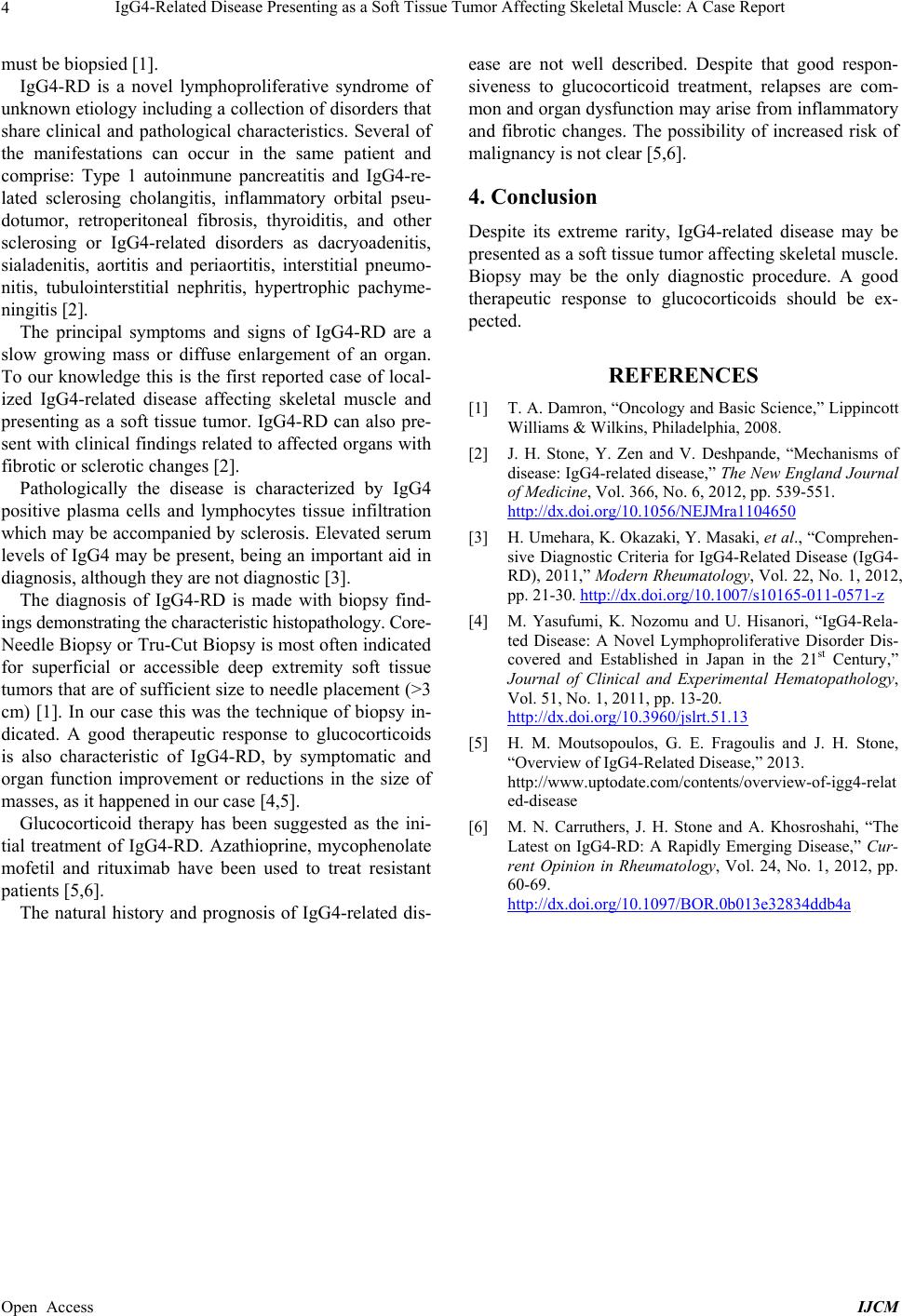
IgG4-Related Disease Presenting as a Soft Tissue Tumor Affecting Skeletal Muscle: A Case Report
4
must be biopsied [1].
IgG4-RD is a novel lymphoproliferative syndrome of
unknown etiology including a collection of disorders that
share clinical and pathological characteristics. Several of
the manifestations can occur in the same patient and
comprise: Type 1 autoinmune pancreatitis and IgG4-re-
lated sclerosing cholangitis, inflammatory orbital pseu-
dotumor, retroperitoneal fibrosis, thyroiditis, and other
sclerosing or IgG4-related disorders as dacryoadenitis,
sialadenitis, aortitis and periaortitis, interstitial pneumo-
nitis, tubulointerstitial nephritis, hypertrophic pachyme-
ningitis [2].
The principal symptoms and signs of IgG4-RD are a
slow growing mass or diffuse enlargement of an organ.
To our knowledge this is the first reported case of local-
ized IgG4-related disease affecting skeletal muscle and
presenting as a soft tissue tumor. IgG4-RD can also pre-
sent with clinical findings related to affected organs with
fibrotic or sclerotic changes [2].
Pathologically the disease is characterized by IgG4
positive plasma cells and lymphocytes tissue infiltration
which may be accompanied by sclerosis. Elevated serum
levels of IgG4 may be present, being an important aid in
diagnosis, although they are not diagnostic [3].
The diagnosis of IgG4-RD is made with biopsy find-
ings demonstrating t he characterist ic hist opathology . Core-
Needle Biopsy or Tru-Cut Biopsy is most often indicated
for superficial or accessible deep extremity soft tissue
tumors that are of sufficient size to n eedle placement (>3
cm) [1]. In our case this was the technique of biopsy in-
dicated. A good therapeutic response to glucocorticoids
is also characteristic of IgG4-RD, by symptomatic and
organ function improvement or reductions in the size of
masses, as it happened in our case [4,5].
Glucocorticoid therapy has been suggested as the ini-
tial treatment of IgG4-RD. Azathioprine, mycophenolate
mofetil and rituximab have been used to treat resistant
patients [5,6].
The natural history and prognosis of IgG4-related dis-
ease are not well described. Despite that good respon-
siveness to glucocorticoid treatment, relapses are com-
mon and organ dysfunctio n may arise from inflammato ry
and fibrotic changes. The possibility of increased risk of
malignancy is not clear [5,6].
4. Conclusion
Despite its extreme rarity, IgG4-related disease may be
presen ted as a sof t tissue tu mor affecting skeletal muscle.
Biopsy may be the only diagnostic procedure. A good
therapeutic response to glucocorticoids should be ex-
pected.
REFERENCES
[1] T. A. Damron, “Oncology and Basic Science,” Lippincott
Williams & Wilkins, Philadelphia, 2008.
[2] J. H. Stone, Y. Zen and V. Deshpande, “Mechanisms of
disease: IgG4-related disease,” The New England Journal
of Medici ne, Vol. 366, No. 6, 2012, pp. 539-551.
http://dx.doi.org/10.1056/NEJMra1104650
[3] H. Umehara, K. Okazaki, Y. Masaki, et al., “Comprehen-
sive Diagnostic Criteria for IgG4-Related Disease (IgG4-
RD), 2011,” Modern Rheumatology, Vol. 22, No. 1, 2012,
pp. 21-30. http://dx.doi.org/10.1007/s10165-011-0571-z
[4] M. Yasufumi, K. Nozomu and U. Hisanori, “IgG4-Rela-
ted Disease: A Novel Lymphoproliferative Disorder Dis-
covered and Established in Japan in the 21st Century,”
Journal of Clinical and Experimental Hematopathology,
Vol. 51, No. 1, 2011, pp. 13-20.
http://dx.doi.org/10.3960/jslrt.51.13
[5] H. M. Moutsopoulos, G. E. Fragoulis and J. H. Stone,
“Overview of IgG4-Related Disease,” 2013.
http://www.uptodate.com/contents/overview-of-igg4-relat
ed-disease
[6] M. N. Carruthers, J. H. Stone and A. Khosroshahi, “The
Latest on IgG4-RD: A Rapidly Emerging Disease,” Cur-
rent Opinion in Rheumatology, Vol. 24, No. 1, 2012, pp.
60-69.
http://dx.doi.org/10.1097/BOR.0b013e32834ddb4a
Open Access IJCM